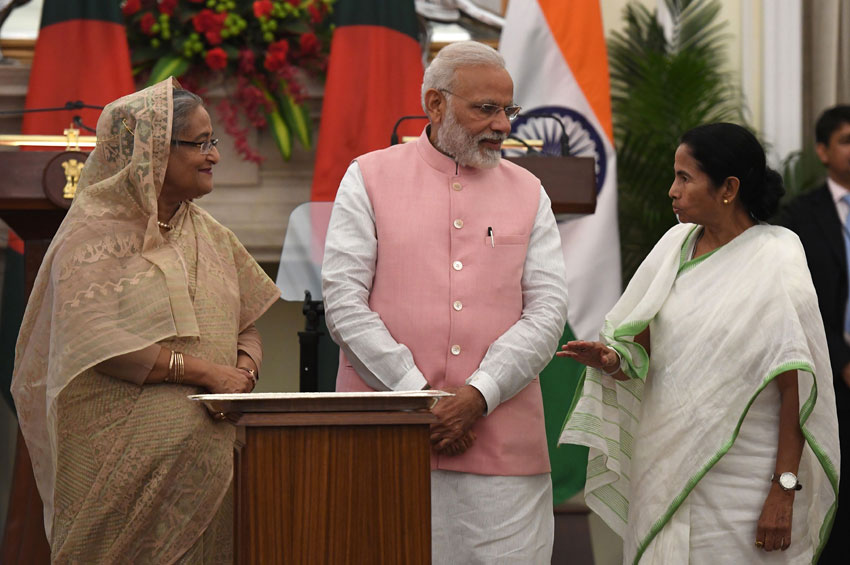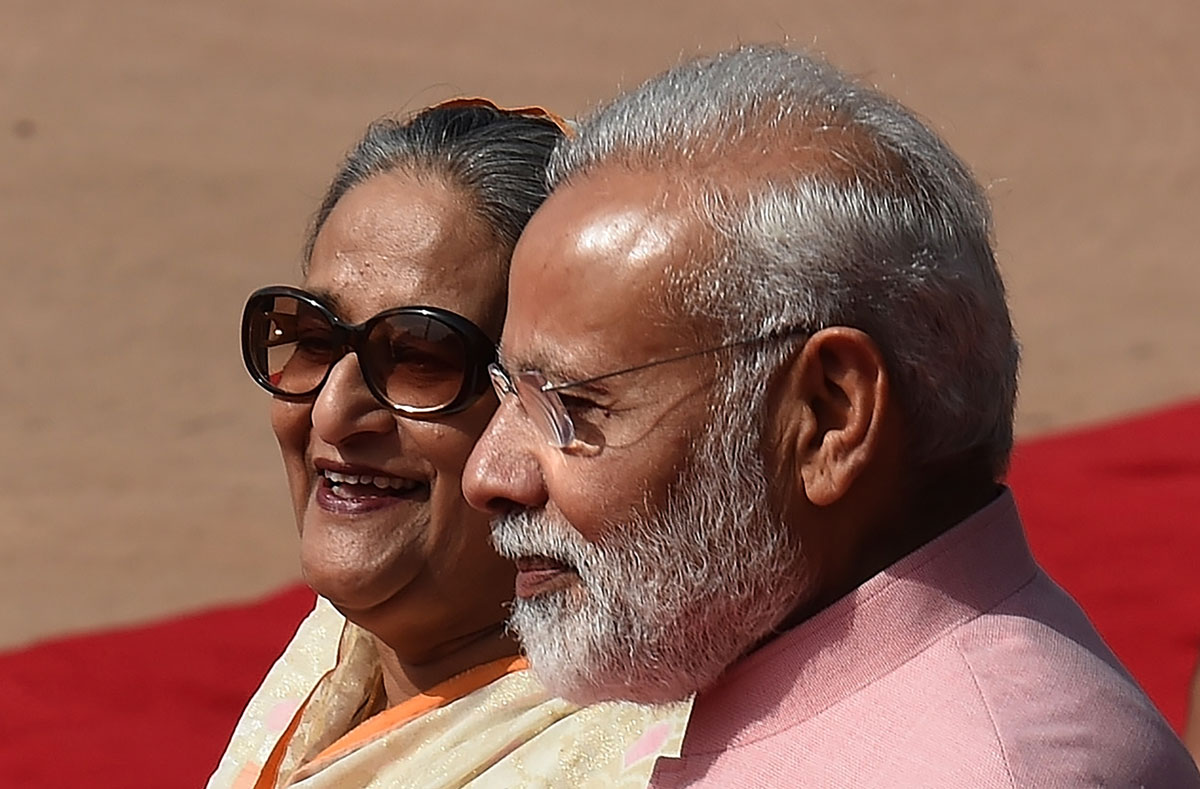To Neutralize China, India deepens South Asia Imprint
Prime Minister Narendra Modi (r) talks with Bangladesh Prime Minister Sheikh Hasina (l) during a ceremonial reception at Presidential house in New Delhi, April 8. (Prakash Singh/AFP/Getty Images)
Over the recent past, energy, whether in the form of electricity or hydrocarbons, has become India’s main instrument to exercise business and strategic influence in its neighborhood, writes Siddharth Srivastava.
The same was on display during the visit of Bangladesh Prime Minister Sheikh Hasina’s to New Delhi recently. Power and gas projects were at the forefront of investment agreements worth over $9 billion committed by both private and state majors including NTPC, Adani, Reliance Power, Petronet LNG and Indian Oil Corp (IOC). Prime Minster Narendra Modi and Hasina signed the framework of understanding (FoU) on cooperation in the hydrocarbon sector, a non-binding five-year agreement that covers the whole gamut of energy cooperation between India and Bangladesh, including ongoing negotiations and other projects that have made more progress.
“Energy security is an important dimension of our development partnership,” Modi said. In a sign of growing mutual trust, Dhaka has granted territorial rights to state-owned refiner and fuel retailer IOC to transport LPG to the remote North Eastern states via corridors within Bangladesh.
Hydrocarbon FoU: One key element in the FoU is the supply of High Speed Diesel (HSD) through the proposed Rs. 3.6 billion, 131-kilometer, one million metric ton per annum Indo-Bangla friendship pipeline that New Delhi has agreed to finance. The project will be a logistical alternative to transporting diesel by rail to Bangladesh. Under a 15-year sale-purchase agreement, Numaligarh Refinery Limited (NRL) will supply diesel from its terminal in Siliguri in West Bengal to Bangladesh Petroleum Corporation (BPC) Depot at Parbatipur. Until the HSD pipeline is built, the gas-oil will be transported on an existing rail line by NRL. Till July, one rake per month will be moved and thereafter two rakes a month will travel to Bangladesh. A big portion of the FoU deals with India’s prominent contribution to the gas-based economy of its eastern neighbor. Bangladesh’s gas production is around 2,700 million cubic feet per day against the demand of around 3,300 million cubic feet per day.
Among the proposals include import of LNG at the under-construction Dharma re-gasification terminal in Odisha, which will then be transported via pipeline up to Dattapulia in West Bengal.
A 70-km pipeline will be laid to Khulna in Bangladesh for moving the gas further. Petronet LNG, meanwhile, has signed a deal with state-owned Petrobangla to set up a Rs. 50 billion LNG import terminal at Kutubdia Island near Chittagong. Petronet was one of the five entities shortlisted to set up the 3.5 million ton LNG import terminal. Competitors included Anglo-Dutch Shell, China’s Huanqiu Contracting & Engineering, Tractebel Engineering of Belgium and Japan’s Mitsui.
Among significant private sector projects, Reliance Power signed an agreement with Bangladesh Power Development Board (BPDB) for Phase-I of the 750 MW LNG power project at Meghnaghat, near Dhaka, valued $1 billion. Reliance Power also signed a $300 million deal with PetroBangla to set up a 500 million standard cubic feet per day LNG terminal at Kutubdia Island.

The China Factor: Hasina’s visit again underlines India’s endeavor to utilize its immense refining, LNG and power generation capacities to leverage its influence over immediate neighbors Nepal, Bhutan, Bangladesh, Sri Lanka, Pakistan and Myanmar. The underlying aim is to minimize China’s ascendancy in the South Asian region, whether strategic, military or economic. Over the years, India’s neutralizing role has also gained the tacit support of America, that see’s India as an effective counterweight to the growing influence of China in Asia. Under Modi, India’s South Asia engagement has gained further urgency. While continuing to consolidate their positions in Nepal, Sri Lanka and Bangladesh, Indian entities are now eyeing Myanmar. According to recent reports, IOC and NRL have mooted proposals to begin fuel retailing operations in Myanmar.
Official sources in IOC have told this writer that the entity has set up a special cell comprising senior experts at its headquarters in New Delhi to co-ordinate projects in the South Asian region.
India and Sri Lanka recently signed an overarching MoU to collaborate in a series of energy and infrastructure projects during the visit of Prime Minister Ranil Wickremesinghe. A flash strike by workers of Ceylon Petroleum Corporation against Colombo’s proposed deal with India to jointly operate an oil storage facility at Trincomalee did not dampen commitment to co-operate on energy, as reflected in statements by Modi and Wickremesinghe. A MoU signed between two sides focuses on enhancing India’s role in boosting gas usage in Sri Lanka. Apart from developing the port, oil tank farms and a refinery at Trincomalee, India proposes to set up a-LNG power plant and terminal at Kerawalapitiya and build a piped gas supply network for Colombo and suburban areas.
The focus of India’s involvement in Trincomalee is to broaden fuel retail operations of Lanka IOC, subsidiary of IOC. New Delhi and Kathmandu, meanwhile, have renewed an ongoing fuel sale deal by another five years. Due to threats by Nepal to import fuel from China that undermines India’s exclusivity, New Delhi has gone the extra mile to placate Kathmandu by committing to meet its entire petroleum products demand and added inducements such as new pipelines, retail and strategic storage facilities. The fuel supply agreement was signed between IOC and Nepal Oil Corp (NOC). The Indian NOC will supply about 1.3 million tons of fuel every year to Nepal for the next five years. New Delhi has also committed to build the 41-km Raxaul-Amlekhganj petroleum product pipeline, also accepting the proposal to extend the project till Kathmandu.
“There has been a distinct shift in India’s neighborhood hydrocarbon strategy over the recent years. Earlier the efforts were concentrated more on expanding upstream operations and influence of state entities such as ONGC. While this continues, India has developed far more expertise in setting up midstream and downstream infrastructure and that’s where the focus rightly lies. The Indian knowledge base in these spheres is among the best globally,” T. Singhal, consultant and former director at India’s oil ministry told this writer. In a recent note Deloitte India has said India has demonstrated technical capability and cost competitiveness in building and operating large refineries. “It makes sense to invest in mega coastal refineries of high complexity to serve growing domestic demand and also to serve markets such as East Africa and Asia,” Deloitte said.
What Next: India has made progress with all its neighbors except the most difficult, Pakistan, where China already has a strong foothold, including in the oil and gas sector. However, there are indications that India is seriously eyeing business prospects with Pakistan with which it shares a fractious relationship. While there are reports that India could be looking to sell gas to Pakistan as well, New Delhi recently gave the go-ahead to Punjab to export surplus 1000 MW power to its western neighbor. Punjab state chief minister Amarinder Singh said the green signal has been given by Modi. If New Delhi is able to establish equations in the energy sphere with Pakistan, prospects of transnational gas pipelines proposed from Turkmenistan and Iran will also brighten. New Delhi’s main fear about the viability of these pipelines is the uncertain and volatile security situation in Pakistan due to which India’s energy security can be held hostage or compromised.


